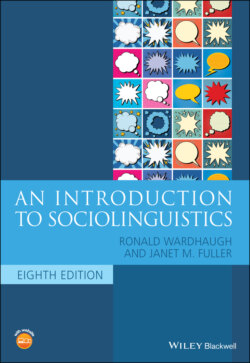Читать книгу An Introduction to Sociolinguistics - Ronald Wardhaugh, Janet M. Fuller - Страница 47
Standard language?
ОглавлениеIt is not at all easy for us to define a standardized language because of a failure to agree about the norm or norms that should apply. For example, Trudgill (1995, 5–6) defines Standard English as the variety which is:
Usually used in print
Normally taught in schools
Learned by non‐native speakers
Spoken by educated people
Used in news broadcasts
Note that this definition revolves around how it is used, not the particular features of the language, as Standard English is constantly changing and developing. While Trudgill writes specifically about Standard English, this is true for all languages. While some languages do have institutions which dictate what is considered standard, this will change over time to recognize new norms. Trudgill also points out that the standard is not the same as formal language, as the standard can also be used colloquially.
What variety is considered the standard is something that is specific to the language; while it is generally a variety associated with a high‐status group, the history behind the development of a particular variety as the normative standard is quite culturally specific. For pluricentric languages such as English, there are different paths to the development of the different regional standards (see also Dollinger 2019 for a discussion about this for German). The standardized variety of British English is based on the dialect of English that developed after the Norman Conquest resulted in the permanent removal of the Court from Winchester to London. This dialect became the one preferred by the educated, and it was developed and promoted as a model, or norm, for wider and wider segments of society. It was also the norm (although not the only variety) that was carried overseas. Today, written Standard English is codified to the extent that the grammar and vocabulary of written varieties of English are much the same everywhere in the world: variation among local standards is really quite minor, so that the Singapore, South African, and Irish standardized varieties are really very little different from one another so far as grammar and vocabulary are concerned. Indeed, Standard English is so powerful that it exerts a tremendous pressure on all such local varieties; we will return to this topic in chapter 13 in our discussion of language planning and policy. However, differences in the spoken varieties exist and are found everywhere in the world that English is used and, while these differences may have been reduced somewhat in the British Isles, they may actually have increased almost everywhere else, for example, within new English‐speaking countries in Africa and Asia.
